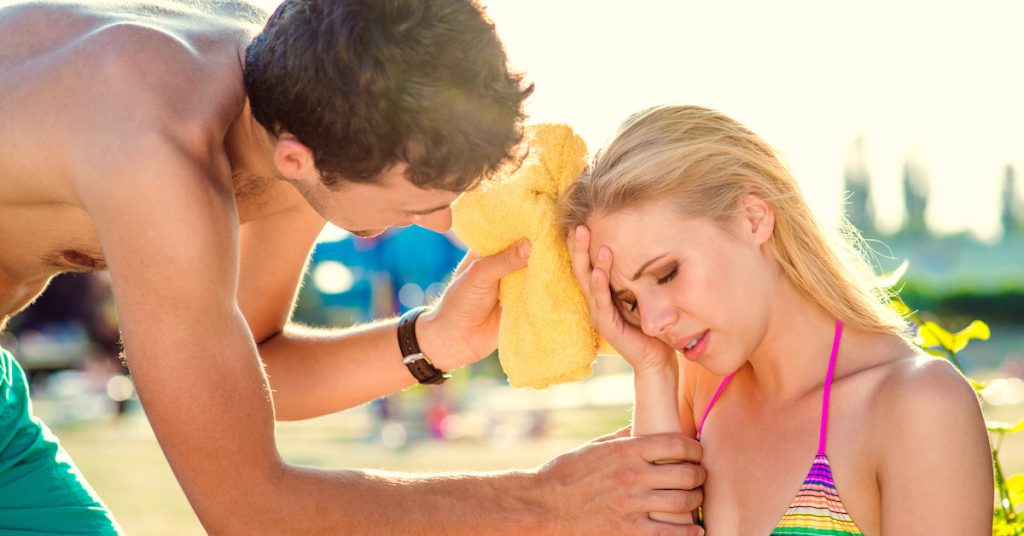
When temperatures start approaching triple digits, it does not take long for the body to become overheated. Even exerting yourself for a relatively short amount of time doing yard work or playing sports can cause your core body temperature to rise to dangerous levels leading to heat stroke. FastMed Urgent Care wants you to know that besides high temperatures and humidity, other potential heat stroke causes include:
- Dehydration, which makes it more difficult to sweat
- Excessive alcohol consumption, which interferes with the body’s ability to regulate temperature
- Dressing inappropriately for the weather, which can make it more difficult for sweat to evaporate and cool the body
Heat stroke causes a variety of symptoms that may develop quickly or gradually as your body becomes unable to regulate your core temperature. Common heat exhaustion and heat stroke symptoms include:
- Cool, clammy skin while in the heat
- Profuse sweating followed by an absence of sweat
- Muscle cramps
- Fatigue
- Feeling faint or dizzy
- Nausea
- Headache
- Weak, rapid pulse
- Decrease in blood pressure when standing
- Increased confusion, agitation, or loss of consciousness
The only heat stroke cure is to take immediate steps to lower the core body temperature and replace depleted fluids and electrolytes. Long-term brain damage and even death can result without prompt heat stroke treatment.
At FastMed, we want you and your family to remain safe as you enjoy your favorite summer activities, so here are five fast facts about heat stroke and heat stroke prevention that you need to know.
1. There is a range of heat-related illnesses.
The mildest form of heat-related illness is heat cramps. At this stage, you may sweat profusely, feel fatigued, thirsty, and experience muscle cramps. These symptoms can typically be treated with rest, getting into cooler temperatures, and drinking water or a sports drink with electrolytes.
If not treated, heat cramps can progress to heat exhaustion, which may cause you to experience additional symptoms, including confusion, nausea or vomiting, pale skin, and a rapid heart rate. Since heat-related illnesses are often accompanied by dehydration, you may also notice a decrease in urination or dark-colored urine. At this point, steps need to be taken to cool the body down as quickly as possible, such as cool showers, sponge baths, or ice packs.
Heat exhaustion can progress to heat stroke if the core body temperature reaches 104°F or higher. At this point, immediate medical treatment is necessary to prevent irreversible damage to the brain and other vital organs.
2. Certain individuals are more susceptible to heat stroke symptoms than others.
Infants and children under the age of four are not able to regulate their body temperature as efficiently as adults, which makes them more susceptible to the effects of high temperatures. The elderly, individuals who are obese or who have chronic illnesses, and anyone who is not accustomed to heat should also exercise caution on hot, humid days.
3. Certain medications can make you more susceptible to heat stroke symptoms.
Certain blood pressure medications, diuretics, allergy medications, tranquilizers, and antipsychotic medications can alter the body’s response to heat or make it difficult to remain hydrated. If you take any of these medications, limit your exposure to the heat, take frequent breaks during strenuous activities, and drink extra fluids to remain hydrated unless your doctor has advised you to limit your fluid intake.
4. Prompt heat stroke treatment is necessary to prevent life-threatening complications.
If rest, fluids, and cooling measures do not relieve your heat-related symptoms within an hour, you should seek immediate medical assistance. Doctors can administer fluids, medications, and use cooling blankets or baths to help lower your core temperature and prevent brain and organ damage.
5. Heat stroke prevention is easy.
A few heat stroke prevention measures can eliminate the need for an emergency heat stroke cure. If you must be outdoors on a hot, humid day, take the following steps:
- Wear lightweight, loose clothing that allows sweat to evaporate so that the body will cool properly.
- A bad sunburn raises the core body temperature and affects your body’s ability to cool itself. When outdoors, wear a sunscreen with a high sun-protection factor, and make sure that you reapply every couple of hours.
- Your body will have less tolerance to the heat early in the season, so you should take things a little slower until your body has had time to adjust.
- Schedule outdoor activities for the coolest part of the day, take frequent breaks, and always have water available.
If you or a loved one experiences heat-related symptoms, FastMed is always available to help, with more than 100 locations throughout Texas, Arizona, and North Carolina. We are open seven days a week, you never need an appointment, and you can check in online for faster service.
About FastMed
FastMed is a leading provider of high-quality, convenient, affordable, and compassionate healthcare in 34 counties across North Carolina. FastMed serves both urban and rural communities across the state with a wide range of care options, including preventive, telemedicine, occupational health, and primary and urgent care. FastMed is one of the few urgent care providers in the nation that has earned The Joint Commission’s coveted Gold Seal of Approval® for quality, safety, and infection control in ambulatory healthcare. For more information, visit www.fastmed.com.